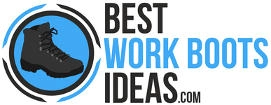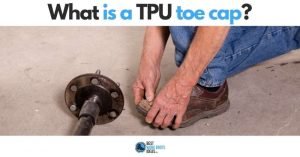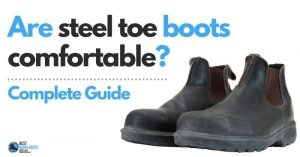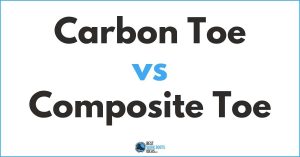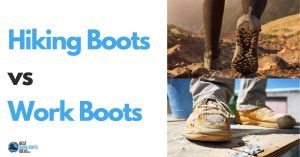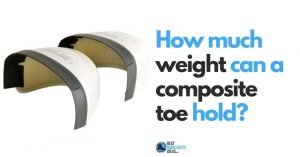Can Work Boots Cause Back Pain? Effective Methods To Reduce Back Pain Through Your Feet
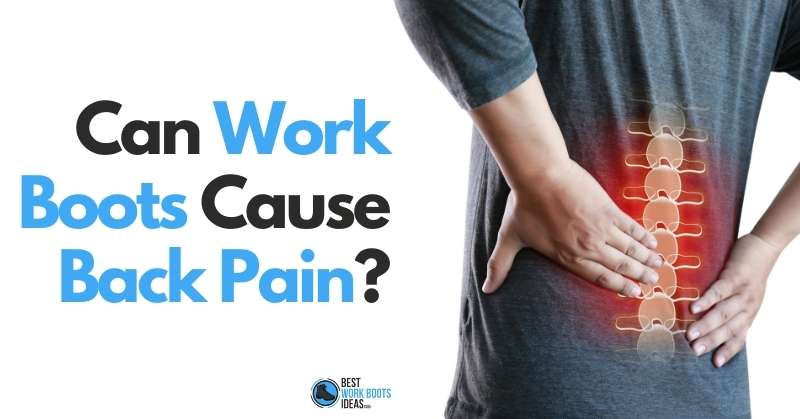
Yes, work boots can absolutely cause back pain. While work boots are designed to protect your feet and ankles against particular injuries, they can also cause other problems. The raised heel, firm insoles, and general rigidity can all contribute to pain in the back.
In this article I’m going to discuss the specific reasons why this may happen and things you can do to reduce this pain.
If you’re experiencing pain, I hope this article will help you with understanding potential causes!
Disclaimer: I am not medically qualified so if you do experience any kind of back pain, please always consult your medical professional first.
Contents
How Can Work Boots Cause Back Pain? The Connection Between Back Pain and Safety Footwear
Work boots can cause back pain due to many reasons.
Their rigid fit on the ankle restricts natural movement.
The heightened heel drop unevenly distributes your body weight, and the rigidity of the boot can cause nerve injuries.
These are not guesses, these are the results of studies that have explored this topic.
Allow me to detail the specific sources and their results to illustrate some of the points mentioned above.
Note From the Author
If you want the specific medical terminology, check the links embedded in this text.
I read many academic articles, and while I understand what they’re communicating, I’m not going to try to wow you with fancy words.
It’s much more educational and productive for me to paraphrase what I’ve read in terms easily understood by anyone.
The most important thing about sharing knowledge is that your audience can understand it, right?
The Effects of Restricting the Ankle
When the ankle is restricted, it can’t do what it was designed to do.
It’s range of motion is extremely limited, but that doesn’t mean we go to work walking like a tin soldier.
Quite the contrary, we do whatever’s necessary to get the job done, further harming our bodies.
A 1998 University of Ottawa publication covered this topic, focusing on the effect that ankle restraint has had on the back and rest of the body.
In that publication, researchers discovered the deeply interconnected nature of the human body.
To save you some time, it’s pages 13-20 of the PDF that will be of greatest interest to you.
There’s 100 pages in the document, but much of it explains the methods used.
I thank the authors for front-loading the pertinent information for my purposes in writing this.
The human body is as close to a perfect, organic system as is possible.
That said, we’ve invented a couple tools over our history that have allowed us to move away from the tropical climates it’s believed we first evolved in.
That made sense for us to do as a species, but these tools (footwear, specifically) change the way in which our bodies operate.
No part of our body works independently, rather, it works in coordination with its connecting parts.
We all learned about this very early on in our lives with the children’s song you might remember.
It went like… “the hip bone’s connected to the…leg bone.
The leg bone’s connected to…” and so on.
Lifting, leaning, bending, when we take part in those actions, something else in our body is compensating to allow us to do it, usually more than one thing.
In the case of the ankle, it was discovered that the calves, feet, and knees were being pushed beyond their functional limits.
In turn, they ask more of their adjacent body parts than they’re capable of.
Now we’re at the thighs, and then the hips, and very quickly we’ve arrived at the area of the body where the spine begins.
It may seem like the ankle is so far removed from the back that it would be impossible for this connection to be true, it’s simply not true.
Science doesn’t care what we think should make sense, it only cares about what’s true.
The Effects of a Raised High Heel on Back Pain
Raised heels often found in work boots adjust the body’s center of gravity.
This causes the wearer to perpetually strain their muscles trying to remain upright.
While you may feel you’re used to this, or even fail to notice it, it has an effect that has been proven through research.
The raised heel alters the gait and stride of the human body. Even though it may seem like you’re walking naturally, you’re not.
This is something that I covered thoroughly in my article on zero drop shoes.
You might also be interested in reading about selecting work boots for flat feet.
Finally, the raised heel changes the distribution of your body weight. Instead of your weight being spread out evenly across the entirety of your foot, it’s concentrated on your heels.
The Effects of a Firm Cushioned Insole
Even though the foot may seem to be a singular object, in reality, it is made of dozens of bones and ligaments operating independently.
The firm insole, steel shank, and hearty outsoles often work to prevent the foot from mechanically operating the way it was designed.
It’s therefore incredibly important to ensure that your shoes have sufficient cushioning.
These are things that I’ve discussed in my articles on metatarsal boots and zero drop boots (again).
If you want to learn more about these topics, check those articles out.
The Effects of Foot Compression
Work boots are often purchased in the wrong size, leading to nerve pain and eventual nerve damage or physical deformity.
As with the other causes of pain, these issues make their way to different areas of the body, most noticeably the back.
To illustrate this point, imagine that you’ve been wearing a pair of composite toe boots that pinch your feet.
After a couple months, you notice a little bit of numbness, but it goes away after you take your boots off at the end of the day, so it’s nothing to worry about.
First, it’s absolutely something to worry about, and it’s probably already changing how you work.
How?
Your feet are a bit numb, so you don’t notice how hard you’re stepping down.
Little jumps that you used to feel in your feet don’t bother you anymore, so you do it more often.
This is creating a chain reaction where you’re sending shockwaves up your legs and into your hips.
You can even be compressing the spine itself by this repeated action.
Harvard Medical School published a helpful guide to help you in the buying process that’s definitely worth checking out.
It might be the thing that prevents you from coming home with a pair of boots that weren’t meant for you!
This is a good reason to purchase safety boots that include some kind of shock absorption and cushioning technology.
Are There Other Reasons Besides My Boots’ Design That Cause Back Pain?
The added weight of the boots is a simple reason that could be causing you back pain.
This is not specific to work boots, as there are other types of heavy footwear. Bunny boots, thick rain boots, or any “heavy-duty” boots can cause back pain as well.
I understand that I’m kind of splitting hairs on this one, but it’s important for me to make this distinction.
There is a particular type of footwear, and then there are certain characteristics it may or may not have.
Many of Doc Martens’ designs are not considered work boots, but boy are they heavy.
I had to retire my pair in my early 20’s for the simple reason that they were causing my knees and hips pain.
It would have only been a matter of time before that pain migrated to my back.
It’s for that reason I’m discussing this with you. It’s not as simple as saying “okay, no work boots, got it.”
You’re going to need to consider the characteristics of work boots that often cause back or other pain.
This is the best rule of thumb to avoid working in pain.
What is the Best Kind of Footwear for Back Pain?
The best type of footwear for back pain is whatever allows your body to move naturally.
That said, you must follow OSHA requirements in certain industries.
Additionally, each human body is different, so there’s no magic answer here.
It’s all about finding a happy medium that allows you to work in comfort while keeping your feet safe, and legal.
No ironworkers wear running shoes, even if it might be more comfortable at the moment they first walk out the door for work.
The best thing you can do is stop assuming things to be true that you don’t actually know.
Listen to your body, look at the most recent research on the topic (there’s quite a lot), and make your decision from there.
What Do I Do About Back Pain Caused By Work Boots?
There are several simple solutions in regards to the back pain that’s caused by work boots.
Correct sizing, more gentle lacing, and the use of insoles when needed will all limit the back pain you’re experiencing .
Get the Proper Sized Boot to Prevent Back Pain!
Making sure you’re wearing the proper sized boot is hands down the most important thing you can do to prevent pain.
Keep in mind that your memory of what your size is might not be the best information to use when selecting a pair of work boots.
It’s also important that you have a good amount of patience going into the footwear buying-process.
As a former contractor and business owner myself, I know how my colleagues and I blow off the things we see as unimportant, and jump right into work.
Remember, if you’re spending any part of the day focused on the pain in your back, feet, or anywhere else, that’s time you’re not working.
It’s not possible to work in pain, or at least it’s not possible to work at maximum efficiency.
I know that when I get shoes, boots, sandals, whatever…I always go in person to try them on. Really?
Yes, really. Every time.
If you’re buying online, check the returns policy so you have enough time to refund or swap if they don’t fit.
Again, trade workers are not a group known for their patience with things like returning the boots they bought online.
I’ve simply thrown It’s way more likely that you’ll just say “they’re fine, work boots don’t feel good, it’s what is.”
If you can manage to force yourself to actually go to a shoe or boot store, you’re going to be better off.
Remember that you might not strike gold with your first selection, and even if you think you like something, try a couple more to make sure you’re sure!
Loosen Your Work Boot Lacing to Prevent Back Pain!
The most important change you can make is loosening how tightly your boots are laced.
It might be that work boots, for the time being, are simply a professional hazard.
That said, there’s no need to do more damage to your body by lacing them to where they’re choking your feet.
This quick, easy solution takes care of a lot of the issues I’ve discussed in this article.
Granted, it doesn’t do anything about the raised heel, but it does limit extreme compression on your feet and ankle.
It gives your feet a little room to move naturally, offsetting the rigidity of the insole and steel shank underneath.
Doing this also limits how much your ankle is restricted, allowing for natural movement in that area as well.
Finally, it’ll prevent the levels of compression that can cause nerve pain or damage.
All that said, it’s still extremely important that you’re wearing the right size for your foot.
Wearing the wrong size and loosening the laces isn’t going to result in a miracle of any sorts.
Get The Proper Insoles and Foot Orthotics to Help Reduce Back Pain!
A proper pair of insoles can be the difference between crippling pain and feeling well.
The arch of your foot might be lacking the support it needs, causing foot pain, aches in your back and elsewhere.
Keep in mind that everyone’s arch is different.
You might be suffering from a lack of support, or even too much support!
I’m not saying this because I read it somewhere, I’m saying that from experience.
Just ensure that your shoe insert provide sufficient arch support.
In January of 2015, I was walking home from work in Hoboken, NJ when it hit me: I couldn’t take another step.
My knees and hips hurt so badly it felt as though I was working towards being immoble.
I know that sounds like the back of the Clif Bar wrapper, but it actually happened.
Sitting there in the cold for about 45 minutes before realizing that no one was coming to get me.
I managed to hobble up 100-stairs (the name of a landmark staircase) to my home in The Heights of Jersey City.
The next day I went to a Walgreens to grab some basic insoles, and within an hour I noticed a difference.
That was great, but I suspected I could do better, and I was right.
I found an orthopedic shoe store, explained my situation, and the owner instantly knew the solution.
He handed me a pair of the Powerstep insoles seen in the photo below. Okay, not that exact pair, but the same style.
I will say, that is actually from my shoe, and you can see that they’ve gotten some solid use.
They were around $50 dollars, and as he saw my eyes widen at the price he said “trust me, it’s worth it.”
I’ve probably spent around $1,000 on insoles since then, and it’s easily the best value I’ve ever gotten in my life.
I bought dress shoes for my wedding that would work with my insoles.
That’s how much my life changed due to this simple purchase.
On another note, having the right orthotics can help with other foot problems such as plantar fasciitis and heel spur.
I Hope I Wasn’t a Pain In Your Back!
This was a long one, sorry!
When making statements that many might disagree with, it’s good to provide ample evidence.
I sincerely hope that you can make a change that alleviates pain in your life.
Work is hard enough, there’s no reason to add physical pain on top of that.
Stay safe, until next time.
